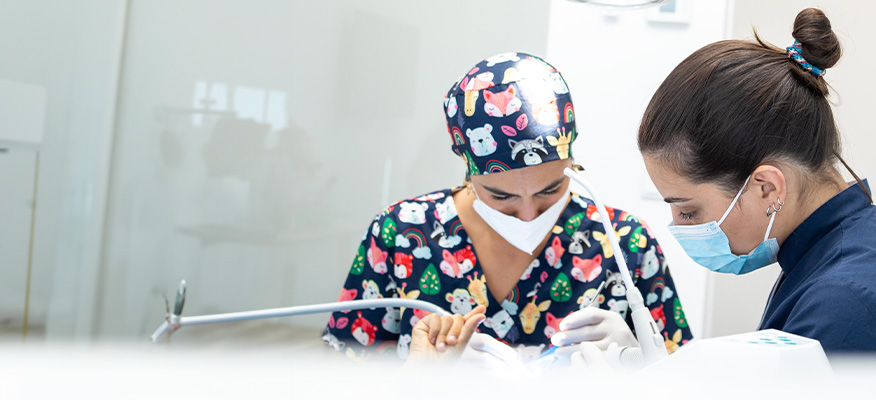
What is Paediatric Dentistry?
Paediatric dentistry is the area of dentistry that promotes the oral health of babies, children, adolescents and patients with special needs, with the aim of ensuring that patients reach adulthood with healthy, aesthetic and functional teeth and that they can maintain them throughout their lives.
Current recommendations are that the first dental appointment should be made when the first milk teeth erupt or, at the latest, within the first year of the child’s life, in order to establish a preventive oral health programme adapted to the child and instruct parents on the most correct eating and oral hygiene habits.
It is also important to monitor the child’s development and assess the eruption of teeth from an early age.
By periodically monitoring the development of the child’s oral cavity, it is possible to ensure correct phonetic, chewing and breathing functions, but also, and above all, to diagnose and prevent potential problems at an early stage.
How often should you go to the paediatric dentist?
The role of the paediatric dentist in prevention has become increasingly important and prominent. Prevention is better than treatment! We want children to maintain a healthy oral cavity and reach adulthood with healthy permanent teeth.
Ideally, when there is good oral health, the child should be seen every six months. In situations where there is a high risk of caries, this frequency should be reduced to three-month intervals.
This periodic monitoring, with regular dental appointments, helps to create a healthy habit and avoids stressful situations for the child.
The earlier you start, the easier it will be for your child to learn to be at the appointment and to cope with going to the paediatric dentist.

What happens at a paediatric dentistry appointment?
The first dental appointment can be a determining factor in the relationship the child will have throughout their life with the dentist and their oral health, and it is essential to provide the best possible experience. The talk-show-do technique, a positive attitude and a lot of empathy make all the difference.
During a paediatric dentistry appointment, a clinical assessment is carried out and the following steps are followed:
- The general development and growth is observed to be appropriate for the age;
- The development and growth of dental structures is examined;
- A clinical oral examination is carried out.
It is also common to carry out simple procedures such as tooth brushing and/or scaling and fluoride application. We avoid invasive procedures in order to ensure that it is a positive experience and that you feel confident about your child’s future appointments.
What are the main paediatric dentistry treatments?
- Application of fissure sealants;
- Removal of caries lesions;
- Frenectomies (repositioning of the labial or lingual bridle);
- Pulp therapy (pulpotomy);
- Treatment of dental trauma;
- Orthodontic treatment;
- Exposure of the crown of erupting teeth;
- Extractions.

At what age do the first teeth appear and when are the teeth complete?
On average, the eruption of the first set of teeth begins between 6 and 8 months of age, with girls generally having them earlier; between 2.5 and 3 years of age, the 20 temporary or “milk” teeth will already be present in the oral cavity.
The permanent or definitive dentition begins between the ages of 5 and 7 and may consist of 32 teeth if the third molars (wisdom teeth) erupt, which is not always the case.
Early or late eruption is not necessarily related to pathology; however, if the child has no teeth after the age of 1, they should be seen at the dental clinic.
How should children’s oral hygiene be carried out?
The characteristics of a child’s brushing depend on various factors, but essentially on the child’s age. Thus, according to the rules of the Directorate-General for Health:
- 0-3 years: before the first tooth emerges, the baby’s oral hygiene should be guaranteed by using a compress moistened with saline or water, which has the function of cleaning the gums by means of a gentle massage. As soon as the first tooth erupts, parents should brush twice a day (one must be done at bedtime), using a soft toothbrush of suitable size. It is possible to start using toothpaste with the appropriate amount of fluoride, provided that the portion used for each rinse does not exceed the size of the child’s 5th finger nail.
- 3-6 years: brushing done progressively by the child, duly supervised and assisted, twice a day (one of which must be at bedtime), using a soft brush of suitable size. The amount of fluoride toothpaste (1000-1500 ppm) should be similar to the size of the child’s 5th finger nail.
- From the age of 6: brushing by the child, duly supervised and assisted if they don’t have sufficient manual dexterity, twice a day (one of which must be at bedtime), using a soft (or alternatively medium) brush. The amount of fluoride toothpaste (1000-1500 ppm) should be the size of a small pea or up to 1cm of toothpaste.


